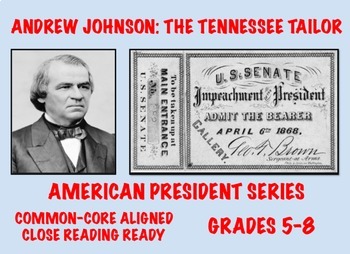Andrew Johnson: U.S. President Biography and Assessment
- PDF
Also included in
- This bundled collection (240+ pages) contains the biographical texts and assessment work I have created for each of America’s first thirty-five presidents, beginning with George Washington and concluding with John F. Kennedy. The life story of each man, from childhood to the presidency and beyond, iPrice $59.00Original Price $85.00Save $26.00
Description
This US History reading and assessment activity helps address several Common Core ELA Standards that are listed below this introduction and is suitable for Grades 5-8. Students read an engaging 900-word biographical text on the 17th American President, Andrew Johnson. The passage follows his life story chronologically, beginning with his humble Southern origins and ending with his last days as a senator from Tennessee after his presidency. Johnson was always a controversial leader, never elected as commander-in-chief, despised by many and loved by only a few due to his ambiguity about slavery and the rights of African Americans, his support of the Union during the Civil War, and his feelings about Reconstruction afterwards. Matters came to a head with his impeachment by the Senate in 1868, which he survived by a single vote.
After the reading are 28 fill-in-the-blank, multiple-choice, and written questions that require application of Common Core Standards to a thorough close reading of the biography. There is also a crossword puzzle for your early finishers or to use as an alternative assessment included with this resource. Answers are provided for all questions.
This resource can be used in a number of ways by teachers (close reading, direct instruction in class, independent practice, absence work, homework, test prep, assessment, centers, etc).
Informational Text Standards
RI.4.1: Refer to details and examples in a text when explaining what the text says explicitly and when drawing inferences from the text.
RI.4.9: Integrate information from two texts on the same topic in order to write or speak about the subject knowledgeably.
RI.5.3: Analyze how a particular sentence, paragraph, chapter, or section fits into the overall structure of a text and contributes to the development of the ideas.
RH.6-8.8: Distinguish among fact, opinion, and reasoned judgment in a text.
L.4.5.c: Demonstrate understanding of words by relating them to their opposites (antonyms) and to words with similar but not identical meanings (synonyms).
This item is a digital download from my TpT store and is bound by copyright laws. The redistributing, editing, selling, or posting of this item (or any part thereof) on the Internet are all strictly prohibited without first gaining express written permission from the author. Violations are subject to the penalties of the Digital Millennium Copyright Act.
Any claims of correlation or alignment to the Common Core State Standards are solely those of Mark Aaron and have not been evaluated or endorsed by the NGA. Mark Aaron is the sole creator of this product and does not claim endorsement or association with the creators of the CCSS.





